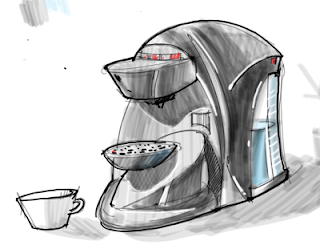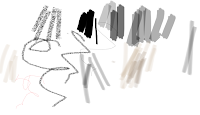Monday, December 31, 2012
In this video we are working on creating a series of very quick sketches of more binoculars. The important part to highlight here is to work with a pencil, developing a series of quick gestural lines that can help us define a shape for later development, video.
Saturday, December 22, 2012
In this 10-minute video I am analyzing how we can draw a pair of binoculars, combining a perspective view with a top view on the same drawing. That way we will be able to transmit as much information as possible to our client in a single concept, video.
Friday, September 28, 2012
How to represent wood and other materials
Please take a look at this video that will show you how to represent exclusively with lines wood and other materials, video.
Wednesday, May 9, 2012
How to sketch a pair of headphones
In this demonstration we will cover how to render this pair of headsets, starting with our ellipses for both ends, video. We worked with two gray markers and two light salmon tones.
Wednesday, May 2, 2012
Rendering a drinking vessel
In this video you will learn how we can draw quickly some concepts for a mug, or a drinking vessel. We explored perspective sketches, plan views and side views too,video and of drinking vessel
Sunday, April 15, 2012
How to start a sketch of an exhibit
In this video you will see how we can start a sketch of an exhibit design, starting with a quick floor plan to help us visualize the main access points, video.
Wednesday, April 11, 2012
How to draw a sofa that looks comfortable
In this video you will learn how to work with your lines to obtain a sofa that looks soft and comfortable, video.
Labels:
grosor de lineas,
industrial design render,
line weights,
render diseño industrial,
sofa rendering
Tuesday, April 3, 2012
Showing textures on a brush with a handle
In this video we are discussing how to add different textures on an object. We are considering ABS, steel, rubber over-molds and bristles, video.
Thursday, March 29, 2012
Rendering a vacuum cleaner
In this video you will learn how to render quickly a concept for a portable vacuum cleaner, video.
Labels:
cintiq tablet,
color markers,
industrial design render,
Prismacolor markers,
wacom tablet render
Sunday, March 25, 2012
How to work with basic geometric shapes
Most industrial design renderings usually have combinations of these simple geometric shapes. Let's review one more time how shadows affect a cylinder, a cone and a sphere,video.
Wednesday, March 21, 2012
How to draw a coffee maker with proper shadows
 Rendering curved objects can lead to confusion on where the light and dark tones should be. We practiced first with a simple cube and two tones of gray, to get this coffee maker done, video.
Rendering curved objects can lead to confusion on where the light and dark tones should be. We practiced first with a simple cube and two tones of gray, to get this coffee maker done, video.
Labels:
cintiq tablet,
gray markers,
gray rendering,
industrial design render,
shadows,
wacom tablet render
Tuesday, March 20, 2012
How to draw ellipses
Working well with ellipses in industrial design can be quite important, especially if we are working with objects that are cylindrical in shape. Watch this video to learn how to work with those ellipses and how to add two types of line weights and some gray marker tones, video
Saturday, March 17, 2012
How to draw shadows on a floor plan
Figuring out how to do our shadows properly in a floor plan can take some practice. Take a look at this quick trick that will allow you to situate most of your shadows correctly, using tracing paper, video.
Labels:
gray markers,
gray scale,
height of furniture,
interior design rendering,
line weights,
orthographic projection,
shadows
Thursday, March 15, 2012
How to draw arrows in ID
Drawing arrows properly in industrial design is important, as we show movement of parts. Take a look at how we made these two arrows to show how a lid opens and how a button could be pushed, video.
Wednesday, March 14, 2012
How to draw a round table and four chairs
In this demonstration you will learn quickly how to set up a drawing that would include four chairs and a circular table. Perspective here has to be maintained clearly, so that we do not get confused with so many lines, video.
Labels:
circular table,
four chairs,
perspective,
rendering ID
Saturday, March 10, 2012
How to draw a Morris chair
Today in this video you will learn how to render this wonderful Morris chair, starting with a simple box in perspective and adding detail little by little, in stages
Tuesday, March 6, 2012
How to draw lamps
Whether we are drawing a lamp or a drinking bottle, we always have to make sure that we relate our circles in perspective (ellipses) to the horizon line, regardless of the scale of the object. In this video, you're going to learn how to relate a lamp to the horizon line, video.
Labels:
ellipse,
lampshade,
perspective,
Render Horizon Line
Sunday, March 4, 2012
How to organize callouts
Drawing and composing call outs is a skill that needs to be mastered in industrial design (and other design disciplines too).
This demonstration has three parts to it; the first two focus on drawing this sideboard and the third one focuses on the callouts.
Setting up our markers
 Setting up your markers is one of the first tasks we need to do when we are ready to render using Adobe Photoshop. Please click on this link to learn how to organize them, video.
Setting up your markers is one of the first tasks we need to do when we are ready to render using Adobe Photoshop. Please click on this link to learn how to organize them, video.
Subscribe to:
Posts (Atom)
















